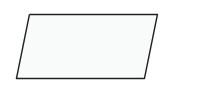The Parallelogram
Reference > Mathematics > Geometry > QuadrilateralsA parallelogram is a quadrilateral in which both pairs of opposite sides are parallel.
If you did the previous reading in this unit, you'll recognize that this definition is similar to the definition of a trapezoid. The difference is in the number of pairs of sides which are parallel.
Here's a picture of a parallelogram:

Parallelograms have some very interesting properties, and we'll talk about several of them here.
Congruent Sides: In a parallelogram, not only are the opposite sides parallel, they're also congruent.
Supplementary Angles: In a parallelogram, every pair of adjacent angles is supplementary.
Congruent Angles: If you think about the previous property for a minute, you will hopefully realize that this means that in a parallelogram, the opposite angles are always congruent.
Congruent Triangles: A diagonal of a parallelogram divides the parallelogram into two congruent triangles. You can prove this using the Alternate Interior Angle theorem and Angle-Side-Angle.
More Congruent Triangles: If you construct both diagonals of a parallelogram, they split the parallelogram into four small triangles. The opposite pairs are congruent. (Alternate Interior Angle theorem and Side-Angle-Side will help you prove this).
Bisected Diagonals: A consequence of the previous property is that each diagonal bisects (cuts in half) the other one.
Area: The area of a parallelogram is simply the base times the height. Be careful, though; you can take any side as the base, but that doesn't mean the adjacent side is the height. The height is the length of a perpendicular segment between the base and the opposite side.
Questions
 The Trapezoid
The Trapezoid The Rhombus
The Rhombus

